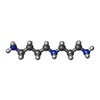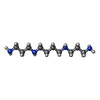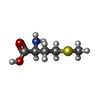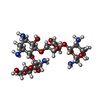+Search query
-Structure paper
| Title | Atomistic simulations of the Escherichia coli ribosome provide selection criteria for translationally active substrates. |
|---|---|
| Journal, issue, pages | Nat Chem, Vol. 15, Issue 7, Page 913-921, Year 2023 |
| Publish date | Jun 12, 2023 |
 Authors Authors | Zoe L Watson / Isaac J Knudson / Fred R Ward / Scott J Miller / Jamie H D Cate / Alanna Schepartz / Ara M Abramyan /  |
| PubMed Abstract | As genetic code expansion advances beyond L-α-amino acids to backbone modifications and new polymerization chemistries, delineating what substrates the ribosome can accommodate remains a challenge. ...As genetic code expansion advances beyond L-α-amino acids to backbone modifications and new polymerization chemistries, delineating what substrates the ribosome can accommodate remains a challenge. The Escherichia coli ribosome tolerates non-L-α-amino acids in vitro, but few structural insights that explain how are available, and the boundary conditions for efficient bond formation are so far unknown. Here we determine a high-resolution cryogenic electron microscopy structure of the E. coli ribosome containing α-amino acid monomers and use metadynamics simulations to define energy surface minima and understand incorporation efficiencies. Reactive monomers across diverse structural classes favour a conformational space where the aminoacyl-tRNA nucleophile is <4 Å from the peptidyl-tRNA carbonyl with a Bürgi-Dunitz angle of 76-115°. Monomers with free energy minima that fall outside this conformational space do not react efficiently. This insight should accelerate the in vivo and in vitro ribosomal synthesis of sequence-defined, non-peptide heterooligomers. |
 External links External links |  Nat Chem / Nat Chem /  PubMed:37308707 / PubMed:37308707 /  PubMed Central PubMed Central |
| Methods | EM (single particle) |
| Resolution | 2.1 - 2.3 Å |
| Structure data | EMDB-28254, PDB-8emm:  EMDB-28255: 70S map for: "Atomistic simulations of the E. coli ribosome provide selection criteria for translationally active substrates"  EMDB-28256: 30S-focused map for: "Atomistic simulations of the E. coli ribosome provide selection criteria for translationally active substrates"  EMDB-28257: 50S-focused map for: "Atomistic simulations of the E. coli ribosome provide selection criteria for translationally active substrates" |
| Chemicals |  ChemComp-MG:  ChemComp-SPD:  ChemComp-SPM:  ChemComp-K:  ChemComp-ZN:  ChemComp-MET:  ChemComp-PAR:  ChemComp-HOH: |
| Source |
|
 Keywords Keywords |  RIBOSOME / RIBOSOME /  tRNA / tRNA /  e. coli e. coli |
 Movie
Movie Controller
Controller Structure viewers
Structure viewers About Yorodumi Papers
About Yorodumi Papers






